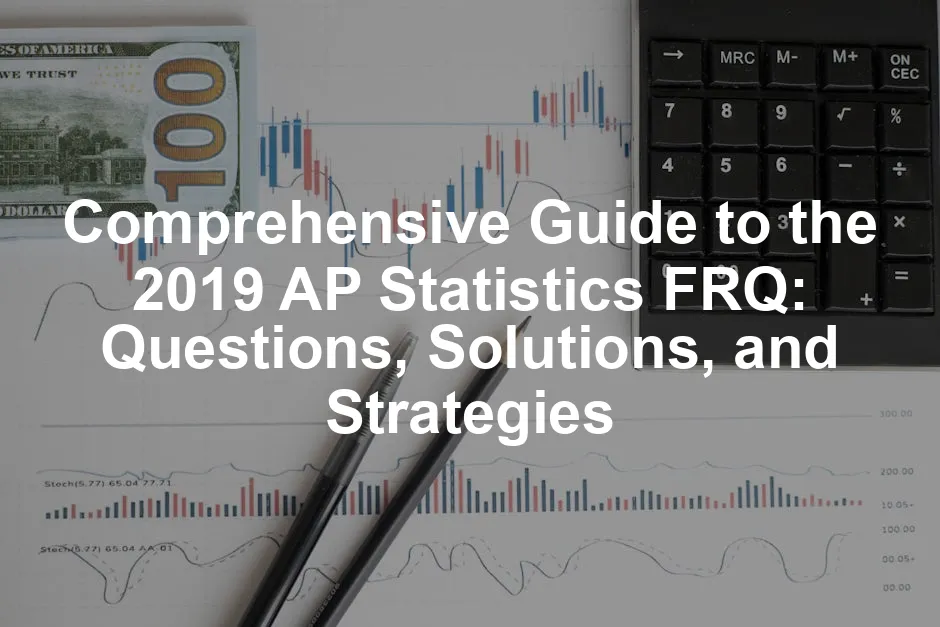Introduction
The AP Statistics exam holds great significance for high school students. It serves as a gateway to college-level statistics. Among its components, Free Response Questions (FRQs) are vital. They assess students’ understanding, analytical abilities, and application of statistical concepts.
The 2019 AP Statistics exam is a fantastic reference point for students preparing for future assessments. It showcases the format and complexity of the questions students can expect. By analyzing the 2019 FRQs, learners can identify common themes and question types, allowing them to approach their studies with greater confidence.
This article is structured to enhance your understanding through a comprehensive breakdown of the 2019 FRQs. We will highlight solutions, discuss common pitfalls, and share effective strategies for tackling these questions. Understanding the solutions to these FRQs can significantly boost your exam performance. It’s not just about getting the right answer; it’s about mastering the process. So, let’s dive in and sharpen those statistical skills!

Understanding the 2019 AP Statistics Exam
Overview of the AP Statistics Exam
The AP Statistics exam is divided into two main sections: multiple-choice questions (MCQs) and FRQs. The MCQs account for 50% of your total score, while the FRQs make up the remaining 50%. This means that how you tackle the FRQs can have a substantial impact on your overall performance.
The FRQ section features six questions that challenge your reasoning and statistical analysis skills. You will encounter a variety of topics, including data collection, probability, statistical inference, and more. Each question requires not only correct answers but also clear explanations and justifications for your reasoning.
In the 2019 exam, the FRQs were designed to test a range of skills and concepts. Students must demonstrate their ability to analyze data sets, interpret results, and apply appropriate statistical methods. Graders look for clarity, accuracy, and the ability to communicate effectively in your responses. Therefore, understanding the format and expectations will help you perform better on the exam.

Importance of Free Response Questions
FRQs are crucial for showcasing your analytical skills. Unlike multiple-choice questions, they require you to articulate your thought process. This is where you can shine! You demonstrate your understanding of how to interpret data, draw conclusions, and apply statistical reasoning.
Moreover, FRQs can cover a broad spectrum of topics, from experimental design to data analysis. This variety prepares you for real-world situations where statistical reasoning is necessary. Understanding how to approach these questions builds a strong foundation for future studies and career opportunities in fields that require data-driven decision-making.
If you’re looking to solidify your understanding, consider grabbing a copy of AP Statistics Exam Prep Book. This resource is tailored to help you navigate the complexities of the exam, ensuring you’re well-equipped to tackle those tricky FRQs!
Understanding data analysis is vital for tackling FRQs effectively. tips for effective data analysis in economics and statistics
Structure of the 2019 AP Statistics FRQs
The 2019 FRQ section included six diverse questions. Each one tested different aspects of statistics, from one-variable data analysis to experimental design and survey interpretation. Notably, the exam reflects a trend toward practical applications of statistical concepts, emphasizing real-world scenarios.
For instance, students analyzed data from real-life experiments, requiring them to apply their knowledge creatively. This change in focus highlights the need for students to not only understand statistical theories but also their practical applications. By familiarizing yourself with the types of questions presented in the 2019 exam, you can gain insight into how to approach similar challenges in your studies and future exams.
In summary, the 2019 AP Statistics exam serves as a vital resource for understanding the expectations and skills required to excel in the subject. Through careful examination of the FRQs, you can enhance your readiness and confidence for the upcoming AP exams.

Importance of Free Response Questions
Free Response Questions (FRQs) are the crown jewels of the AP Statistics exam. Why, you ask? Because they showcase your analytical prowess and data interpretation skills. Unlike multiple-choice questions, where guessing might get you somewhere, FRQs demand clarity and reasoning. This is your moment to shine!
FRQs challenge you to dissect data and draw meaningful conclusions. They require a logical approach to problem-solving. It’s not just about crunching numbers; it’s about conveying your thought process. This skill is invaluable, especially in a world awash with data. Employers love candidates who can interpret and present data effectively.
And while you’re honing those skills, why not treat yourself to a Math-Themed T-Shirt? Because studying statistics should come with a side of style, right?
Moreover, FRQs cover a wide array of topics, from experimental design to statistical inference. This variety simulates real-world scenarios where statistical reasoning is essential. Mastering these questions prepares you for future studies and careers that rely on data-driven decisions. So, embrace the challenge! Your analytical skills will thank you later.
Understanding statistical inference is crucial for effective data interpretation. statistical inference for estimation in data science colorado
Structure of the 2019 AP Statistics FRQs
The 2019 AP Statistics FRQ section included six diverse questions that tested various statistical concepts. Each question required students to demonstrate their analytical skills and understanding of real-world applications.
Notably, the exam featured questions on one-variable data analysis, experimental design, and interpreting survey data. This year, the trend shifted towards practical applications, emphasizing how statistics relate to everyday life. For instance, students explored the effectiveness of a fungus in controlling insect populations. This practical angle is a welcome change, making the exam more engaging and relevant.
Additionally, the 2019 FRQs highlighted the importance of clear communication in statistical reasoning. Students had to articulate their methods and findings effectively. This focus on clarity is a crucial skill, as it mirrors the expectations of many employers in data-centric fields. By understanding the types of questions presented in the 2019 exam, you can better prepare for similar challenges in your studies and future assessments.

FRQ #3: Survey Data Interpretation
Description
In this question, a medical researcher surveyed a diverse group about medication adherence. The responses were categorized as never, sometimes, or always. This setup presents a classic case of interpreting survey data, which is essential in statistics. The goal? To analyze the relative frequency of each response category.
Solution Breakdown
To tackle this question, start by calculating the relative frequencies. This involves dividing the number of respondents in each category by the total number of responses. A pie chart or bar graph can visually represent these frequencies, making it easier to interpret the data.
Next, consider the statistical reasoning required. You’ll need to evaluate if the sample is representative of a larger population. This leads us to the potential biases. Was the sample randomly selected? If not, the results might skew perceptions about medication adherence.
Common biases include selection bias and response bias. Selection bias occurs when certain groups are over- or under-represented. Response bias happens when participants might not answer truthfully. Both can affect how we interpret results and make conclusions.

FRQ #4: Comparing Proportions
Description
This question involves comparing two proportions regarding kochia plants and their resistance to glyphosate. Two years’ data were presented, and the task was to determine if there’s statistical evidence of increased resistance.
Solution Breakdown
To compare the two proportions, a z-test for proportions is necessary. Calculate the sample proportions for both years. The formula for the z-statistic is essential here. You’ll use the pooled proportion to calculate standard error, which is crucial for deriving the z-value.
After calculating the z-score, consult the standard normal distribution table to find the corresponding p-value. This p-value will help you decide if the observed difference in proportions is statistically significant.
Next, reflect on the implications of your findings. A significant increase in resistance could imply a need for new herbicides or modifications to current agricultural practices. Discussing these implications helps demonstrate a deeper understanding of the data beyond mere calculations.
By structuring your response clearly and logically, you can effectively convey your statistical reasoning and findings.

FRQ #5: Normal Distribution
Description
In this question, a smartphone manufacturer discusses their new battery. The battery life is normally distributed, boasting a mean of 30 months and a standard deviation of 8 months. The warranty lasts for two years, or 24 months. The question asks whether the company will need to replace the battery for a significant number of customers. To solve this, students must calculate the proportion of batteries that fail within the warranty period.
Solution Breakdown
To tackle the problem, start by determining the z-score for 24 months. The z-score formula is:
z = (X - μ) / σ
Plugging in the values, we find:
z = (24 - 30) / 8 = -6 / 8 = -0.75
Next, consult the standard normal distribution table to find the area to the left of this z-score. This area represents the proportion of batteries that fail before 24 months. For a z-score of -0.75, the area is approximately 0.2266.
This indicates that about 22.66% of batteries will fail within the warranty period. While this might seem low, it translates to a significant number of replacements when the company sells thousands of units.
Now, pitfalls can arise if students overlook the normal distribution’s properties. Assume the distribution is normal and not skewed; otherwise, the results could be misleading. Also, ensure that calculations are performed accurately.

FRQ #6: Data Collection and Sampling
Description
This question revolves around sampling methods used to study rental prices for one-bedroom apartments in a large city. Emma collects a random sample of 50 prices from a website listing available apartments. The question prompts students to evaluate the sampling method’s effectiveness and the potential biases involved.
Solution Breakdown
To provide a strong solution, emphasize proper sampling techniques. A random sample is crucial for reducing bias. Explain that each apartment should have an equal chance of being selected. This ensures that the sample accurately represents the population.
Common errors often occur when students neglect the sample size. A sample of 50 may not be sufficient, especially in a diverse city with varying price ranges. Therefore, students should discuss the impact of sample size on the reliability of their findings.
Another frequent misstep is failing to account for self-selection bias. Since the data comes from listings, it may exclude apartments that aren’t advertised. Such omissions can skew the results and lead to incorrect conclusions about rental prices.
In summary, highlight the importance of rigorous data collection methods. By addressing potential biases and adhering to good practices, students can enhance the quality of their statistical conclusions.

Utilizing Past FRQs for Practice
Practicing with past Free Response Questions (FRQs) is like hitting the gym before the big game. You wouldn’t run a marathon without training, right? Similarly, familiarizing yourself with FRQs helps you understand question formats. The AP Statistics exam has its quirks, and knowing these can give you an edge.
Each FRQ varies in style and complexity. This variety prepares you for the unexpected twists on exam day. By working through previous years’ questions, you gain confidence. You’ll recognize patterns and develop strategies for tackling each question type. This practice isn’t just about answering; it’s about honing your statistical reasoning.
Consider forming study groups to work on these past questions. Discussing your thought processes can deepen your understanding. Remember, teamwork makes the dream work, especially in stats!
To enhance your study sessions, consider investing in a Study Desk Organizer. A tidy workspace can lead to a tidy mind, and we all know how important that is during those intense study sessions!

Tips for Managing Exam Time
Time management during the AP Statistics exam is crucial. You have roughly 90 minutes to tackle six FRQs. Seems daunting, right? Fear not! Here are some strategies to keep you on track.
First, read all questions thoroughly. This initial read helps you gauge which questions seem easier. Start with the ones you feel most confident about. This approach boosts your morale and conserves time.
Next, allocate time wisely. Aim for about 15 minutes per question. If you hit a snag, don’t dwell on it! Move on and return later.
Lastly, keep an eye on the clock. A simple wristwatch can be your best friend here. Regularly check your progress to ensure you’re not racing against time at the end.
And to help you focus while you’re studying, consider using Noise-Canceling Headphones. They can help drown out distractions and keep you in the zone!

Conclusion
In conclusion, mastering FRQs is vital for success in the AP Statistics exam. The ability to articulate your statistical reasoning can set you apart from other test-takers. Remember, these questions challenge not just your math skills but your ability to think critically and communicate effectively.
Utilizing past FRQs for practice is an invaluable strategy. It allows you to familiarize yourself with question formats and expectations. Engage with the material actively, and don’t hesitate to seek additional resources if needed.
Managing your time effectively during the exam is equally important. Start with the questions you are comfortable with and keep a steady pace. This will help you avoid the dreaded time crunch at the end.
In essence, consistent practice and strategic preparation can significantly improve your performance. Embrace the challenge, and approach your studies with curiosity and enthusiasm. You’ve got this!

FAQs
What resources can I use to prepare for the AP Statistics FRQ section?
Preparing for the FRQ section can be a breeze with the right resources. Start with recommended textbooks like “The Practice of Statistics” by Daren Starnes. Online platforms such as Khan Academy and Coursera also offer excellent AP Statistics courses. Additionally, practice exams from the College Board website provide real exam experience. Don’t forget to check out YouTube channels dedicated to AP Statistics for visual explanations.
How can I improve my statistical reasoning skills?
Improving your statistical reasoning skills is all about practice and engagement. Start by working with real-world data. Analyze trends, make predictions, and interpret results. Websites like Kaggle offer datasets for exploration. Join online forums or study groups to discuss findings and insights. Engaging with peers can enhance your understanding and spark new ideas.
What are the scoring guidelines for the AP Statistics FRQs?
Scoring for FRQs is based on a rubric that focuses on clarity, accuracy, and reasoning. Each response is evaluated on how well it addresses the question and supports conclusions with appropriate statistical methods. Graders look for logical organization and effective communication. It’s crucial to show your work and explain your thought process clearly.
How important is it to understand the context of each question?
Understanding the context of each question is essential for answering FRQs effectively. Context provides the framework for analysis. It helps you determine which statistical methods to apply. Without context, your response may lack the necessary depth. Pay attention to details in the questions; they often contain clues for the best approach.
Please let us know what you think about our content by leaving a comment down below!
Thank you for reading till here 🙂
All images from Pexels




